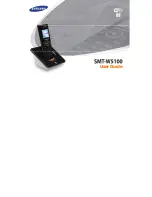
9
always clearly marked. They include below deck on boats, chemical transfer or storage facilities, vehicles using liquefied petroleum
gas, and areas where the air contains chemicals or particles such as grain dust or metal powders.
Sensitive Electronic Equipment
The current state of research concludes that operational DECT phones normally do not adversely affect electronic equipment.
Nevertheless, you should take some precautions if you want to operate DECT phones in the immediate vicinity of such equipment
like sensitive laboratory equipment. Always keep a minimum distance of 10 cm (3.94“) to the equipment even when the phone is in
standby.
Electrical Surges
We recommend the installment of an AC surge arrester in the AC outlet to which this device is connected to avoid damage to the
equipmen t caused by local strikes of lightening or other electrical surges.
Important Battery Information
CAUTIONS
The handset uses a rechargeable battery pack, model name Ni-MHAAA550mAh 2.4V (NI-MHAAA550*2), supplier Yiyang Corun
Battery Co., Ltd.
• Only use the battery that came with the handset or a replacement battery obtained from Snom Technology. Do not use any other
type of battery since this may lead to leakage, fire, explosion, or other dangerous situations.
• Avoid using the battery when it has been exposed to extremely high or low temperatures during use, storage, or transportation.
• Avoid using the battery in extremely low air pressure at high altitudes.
• Leaving the battery in an environment with extremely high temperatures and/or extremely low air pressure may result in an
explosion or the leakage of flammable liquid or gas.
• Never disassemble, alter, or short-circuit batteries or use them for purposes other than the intended one.
Charging and Discharging, Storage
• CAUTION
: Risk of explosion if battery is replaced by an incorrect type. Dispose of used batteries according to the instructions.
• Charge the battery only inside the handset.
• The full performance of a new battery is achieved only after two or three complete charge and discharge cycles.
• The battery can be charged and discharged hundreds of times, but it will eventually wear out. Use only Snom Technology GmbH
approved batteries.
• If left unused, a fully charged battery will lose its charge over time. If the batteries are completely discharged, it may take a few
minutes before the charging indicator appears on the display.
• Use the batteries only for their intended purpose. Do not short-circuit the batteries. Short-circuiting the terminals may damage
the batteries or the connecting object. Do not use a damaged charger or battery. Using a damaged battery may cause it to
explode.
•
Do not place or store the batteries, inside or outside the handset, in the immediate vicinity of open fire or other heat sources.
• Leaving the batteries in hot or cold places will reduce their capacity and lifetime. Charge batteries within an ambient
temperature range of 0 °C to 40° C. A device with hot or cold batteries may not work temporarily, even when the batteries are
fully charged.
• Avoid overcharging. Repeated overcharging can lead to deterioration in battery performance. Never attempt charging the
batteries with reversed polarity as this may cause the gas pressure inside the batteries to rise and lead to leakages.
• Remove batteries if storing phone for more than 1 month.
• Store batteries in a cool, dry place without corrosive gases.
Battery Disposal
Defective or exhausted batteries should never be disposed of as municipal waste. Return old batteries to the battery supplier, a
licensed battery dealer or a designated collection facility. Do not dispose a battery into fire or a hot oven, or mechanically crush or
cut a battery which can result in an explosion.
Cleaning
Use an anti-static cloth. Please avoid water and liquid or solid cleaning products as they might damage the surface or internal
electronics of the base, charger, and handset.










































